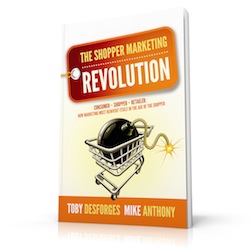 Shopper Marketing is definitely a buzz. Expenditure is growing, teams are exploding in size (just check out how many job ads there are in the space!). This is good news for the consumer goods industry; there is a need to move on to a more effective model – but it does beg the question – why now? And what is really different about what is called “shopper marketing” to what has gone before?
Shopper Marketing is definitely a buzz. Expenditure is growing, teams are exploding in size (just check out how many job ads there are in the space!). This is good news for the consumer goods industry; there is a need to move on to a more effective model – but it does beg the question – why now? And what is really different about what is called “shopper marketing” to what has gone before?
After all, shoppers have existed for as long as there have been shops. The approximation that the consumer is the shopper which I have railed against so strongly has, after all, been around for a very long time too– so why is it becoming such a hot topic now? Why is it in this decade that I choose to pull my soapbox out? Why is it now that I have chosen, together with my buddy Toby Desforges, to write a book, The Shopper Marketing Revolution, in an attempt to galvanize significant change in the way the consumer goods industry works? In short: Why now?
There are lots of reasons. The consumer goods industry is getting more competitive; consumers are harder to pin down through traditional media; the costs of trading with mega retailers are going up: all of these put pressure on the historic models used in the consumer goods industry. All this points to an urgent need to change. But why is shopper marketing the salvation?
The reasons are actually quite simple, and go to the heart of what shopper marketing is, and is not. What has gone before was rarely shopper marketing. It was doing activities in front of shoppers. There is a difference. The age of shopper marketing – The Shopper Marketing Revolution – is ushered in by the need to actually market to shoppers: to lift the game, if you will, to taking fundamental marketing tools, techniques and practices and applying them to a new target – the shopper. The keys to this are as follows.
Shoppers are different
Whilst shoppers have always been different, the differences are greater now. The paths by which shoppers get from ‘desire’ to ‘purchase’ are far more diverse. This has two key implications, which really open up the power of shopper marketing in a way which perhaps was not apparent before.
Shoppers are now more heterogeneous than ever
Shoppers used to be far more similar. For example – they had all been exposed to similar media, in similar doses – so their understanding of the brand would be far more similar. Today one shopper may hardly be aware of your brand: another may have researched heavily and significantly before entering a store. As a shopper enters a store, they may be fundamentally different in many key aspects of their relationship to your brand and the category it is in. Under these circumstances, talking about ‘the shopper’ is simply not good enough. Rather, it is about different shoppers in different environments, wanting different things in different ways at different times. Modern marketing is all about this: how to segment and then target different segments of the population. This marks the move from ‘retail marketing’, ‘trade marketing’ and ‘category management’. Little in these disciplines was actually ‘marketing’. Shopper marketing changes that. We need to market to these people, not just throw activity at them.
Multiple points of influence
Shoppers have more choice than ever. There is a shift in the power of the retail world. Not so long ago, shoppers often had little choice of where to shop, so what they could buy was to a large extent dictated by retailers. No more. Channel proliferation has been huge: first with new types of offline stores (think of the explosion in convenience stores, hard discounters and dollar stores) and then online too. Different shoppers, in different stores. This takes shopper marketing from a theory into something that can be actioned. Time and again we find different types of shoppers in different stores. The potential to adjust the marketing mix by channel to better suit the shoppers there is enormous, and is missed by most so-called ‘shopper marketers‘..Now we can really be targeted in our activity, focusing on the shoppers we are really interested in, in an environment where large numbers of them are present and open to influence.
This is not all about digital
There is a lot of talk about digital and the “omnichannel” world it creates. This isn’t new. Even without digital there were different shoppers and different channels. Digital is merely the next evolution in this marketing journey – and it has exposed this weakness/opportunity in the consumer goods model, which has arguably been there for decades. Digital has arguably created the tipping point, a point where older models of marketing finally become untenable: creating both the need and the opportunity to create a different way of marketing consumer goods.
That is why the time is now: if you want to find out more, you can check out The Shopper Marketing Revolution – now available on Amazon!


